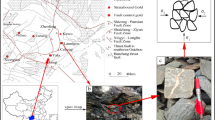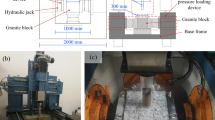Abstract
Particle impact drilling (PID) is a promising technology to enhance the rate of penetration in hard and abrasive formations. The changes to physical and mechanical properties near the crater of a full-size tight sandstone sample after successive impacts of a steel-particle water jet are investigated by different scales of rock physics measurements to estimate the range of the damage zone. Similar measurements are also carried out on a sample from the same formation without steel-particle water jet as a reference. The results indicate that: (i) there is a damage zone around the crater with induced cracks and pore collapse caused by the impact stress wave produced by the steel-particle water jet. The dimensionless depth of the damage zone from the crater’s surface is about 0.69 times the jet diameter (d0). Within the damage zone, the dense compaction zone is just near the crater surface within a dimensionless distance of about (0.02–0.06) d0, where the porosity and the permeability slightly decrease, and show significant strength decrease. (ii) The changes of the porosity and the P- and S-wave velocities after steel-particle water jet at core scale are neglectable. Compared to the reference sample, the permeability at the lateral of the crater is (4.52–30.90) times higher, while the permeability beneath the bottom of the crater is 79% lower. The uniaxial compressional strength (UCS) decreases by 15.6%–65.7%. (iii) The indentation hardness after particle jetting shows a significant decrease. The macro-indentation hardness decreases from 1.92 GPa to 1.30 GPa at core scale. Within the damage zone, the hardness and the Young’s modulus calculated from nanoindentation tests decrease with the increase of the distance to the crater’s surface. This work as a case study provides new experimental evidence of the evolution of rock damage by the impact stress of the steel-particle water jet.
Highlights
-
The dimensionless depth of the damage zone from the crater’s surface is about 0.69 times jet diameter.
-
Permeability is (4.52–30.90) times higher at the laterals of the crater.
-
Macro-indentation hardness and UCS decrease significantly in the damage zone.
-
Nanoindentation hardness decreases with its distance to the crater’s surface.










Similar content being viewed by others
Data Availability
The datasets generated during and/or analyzed during the current study are available from the corresponding author on reasonable request.
References
Aziznajad S, Esmaieli K, Hadjigeorgiou J, Labrie D (2018) Responses of jointed masses subjected to impact loading. J Rock Mech Geotech Eng 10:624–634
Banadaki MMD, Mohanty B (2012) Numerical simulation of stress wave induced fractures in rock. Int J Impact Eng 40–41:16–25. https://doi.org/10.1016/j.ijimpeng.2011.08.010
Brown ET (ed) (1981) Rock characterisation, testing and monitoring. ISRM Suggested Methods. Pergamon Press, Oxford
Cheng P, Zhang CP, Ma ZY, Zhou JP, Zhang DC, Liu XF, Chen H, Ranjith PG (2022) Experimental study of micromechanical properties alterations of shale matrix treated by ScCO2-Water saturation using nanoindentation tests. Energy 242:122965. https://doi.org/10.1016/j.energy.2021.122965
Dehkhoda S, Hood M (2013) An experimental study of surface and sub-surface damage in pulsed water-jet breakage of rocks. Int J Rock Mech Min Sci 63:138–147. https://doi.org/10.1016/j.ijrmms.2013.08.013
Dehkhoda S, Hood M (2014) The internal failure of rock samples subjected to pulsed water jet impacts. Int J Rock Mech Min Sci 66:91–96
Du Y, Wang R, Ni H, Li M, Song W, Song H (2012) Determination of rock-breaking performance of high-pressure supercritical carbon dioxide jet. J Hydrodyn (ser. B) 24:554–560
Fang TC, Ren FS, Wang BJ et al (2021) Particle jet impact deep-rock in rotary drilling: failure process and lab experiment. PLoS One 16(4):e0250588
Farmer IW, Attewell PB (1965) Rock penetration by high velocity water jet: a review of the general problem and an experimental study. Int J Rock Mech Min Sci 2:135–153
Foldyna J (2019) Recent developments in pulsating water jets [M]. In: Hloch S, Klichová D, Krolczyk G, Chattopadhyaya S, Ruppenthalová L (eds) Advances in manufacturing engineering and materials. Lecture Notes in mechanical engineering. Springer, Cham
Hardisty T (2007) Particle drilling pulverizes hard rocks. Am Oil Gas Report 50(7):86–89
Kuang Y, Zhu Z, Jiang H, Wu K, Wang Q (2012) The experimental study and numerical simulation of single-particle impacting rock. Acta Pet Sin 33(6):1059–1063
Kuang Y, Lin W, Xu X et al (2016) Study on the fragmentation of granite due to the impact of single particle and double particles. Petroleum 2:267–272
Li XB (2014) Rock dynamics fundamentals and applications [M]. Science Press, Beijing
Li M, Ni H, Wang R, Xiao C (2017) Comparative simulation research on the stress characteristics of supercritical carbon dioxide jets, nitrogen jets and water jets. Eng Appl Comput Fluid Mech 11:357–370
Lu YY, Li XH, Xiang WY (2005) Rock erosion mechanism of cavitating water jets. Rock Soil Mech 26(8):1233–1237
Mindline RD (1949) Compliance of elastic bodies in contact. J Appl Mech 16:259–268
Nag A, Hloch S, Dixit AR et al (2020) Utilization of ultrasonically forced pulsating water jet decaying for bone cement removal. Int J Adv Manuf Technol 110:829–840. https://doi.org/10.1007/s00170-020-05892-9
Ni H, Wang R (2004) A study of the rock breaking mechanism during swirling water jet drilling. Petroleum Sci 1:39–44
Oliver WC, Pharr GM (1992) An improved technique for determining hardness and elastic modulus using load and displacement sensing indentation experiments. J Mater Res 7:1564–1583. https://doi.org/10.1557/JMR.1992.1564
Oliver WC, Pharr GM (2004) Measurement of hardness and elastic modulus by instrumented indentation: advances in understanding and refinements to methodology. J Mater Res 19:3. https://doi.org/10.1557/jmr.2004.19.1.3
Qin J, Pang X, Zhang Z, Fikeni KG (2021) Multiscale characterization of oilwell cement cured HPHT conditions [C]. In: The ARMA 55th US rock mechanics/geomechanics symposium, Houston, Texas, June 20–23, 2021 ARMA 21-1114.
Raj R, Chattopadhyaya S, Mondal A (2020) A review on continuous and pulsed water jet machining. Mater Today Proc 27:2596–2640. https://doi.org/10.1016/j.matpr.2019.11.071
Ren FS, Fang TC, Cheng XZ (2020) Study on rock damage and failure depth under particle water-jet coupling impact. Int J Impact Eng 139:103504. https://doi.org/10.1016/j.ijimpeng.2020.103504
Riedel W, Kawai N, Kondo K (2009) Numerical assessment for impact strength measurements in concrete materials. Int J Impact Eng 36:283–293
Szwedzicki T (1998) Indentation hardness testing of rock. Int J Rock Mech Min Sci 35(6):825–829. https://doi.org/10.1016/S0148-9062(97)00334-3
Tadic DM (2003) Investigation of cavitating and pulsed high pressure water jet devices for process scale removal. University of Queensland, Brisbane, Australia
Tian F, Lin M (2007a) Studies on the mechanism of water jet-assisted drilling technology (1): cavitation and erosion. Mech Eng 29(1):29–33
Tian F, Lin M (2007b) Studies on the mechanism of water jet-assisted drilling technology (2): cavitation and erosion. Mech Eng 29(2):34–39
Tripathi R, Hloch S, Chattopadhyaya S, Klichova D, Scucka J, Das AK (2020) Application of the pulsating and continuous water jet for granite erosion. Int J Rock Mech Min Sci 126:104209
Tu ZG, Lu Y (2010) Modifications of RHT material model for improved numerical simulation of dynamic response of concrete. Int J Impact Eng 37(10):1072–1082
Wang FX (2017) Research on particle water jet modulation and rock breaking mechanism. China University of Petroleum (Huadong). Qingdao, Phd thesis
Wang M, Wang R (2006) Euler/Euler theory and application of fluid-particle two-phase jet. J Hydrodyn Ser B 18(3):120–124
Wang RH, Wang FX, Zhou WD, Xu YJ, Wang MB, Zhong GY (2016) Particle impact drilling technology: the state of the art and perspective development. J China Univ Pet (natural Science Edition) 40(6):71–79. https://doi.org/10.3969/j.issn.1673-5005.2016.06.009
Wang FX, Wang RH, Zhou WD, Chen GC (2017) Numerical simulation and experimental verification of the rock damage field under particle water jetting impacting. Int J Impact Eng 102:169–179. https://doi.org/10.1016/j.ijimpeng.2016.12.019
Wang H, Zhu L, Xu B (2018) Principle and methods of nanoindentation test. Residual stresses and nanoindentation testing of films and coatings. Springer, Singapore
Wijk G (1989) The stamp test for rock drillability classification. Int J Rock Mech Min Sci Geomech. 26(1):37–44
Xia K, Yao W (2015) Dynamic rock tests using split Hopkinson (Kolsky) bar system- a review. J Rock Mech Geotech Eng 7:27–59
Xu YJ, Zhao HX, Sun WL, Ren JH, Qian HB (2009) Numerical analysis on rock breaking effect of steel particles impact rock. J China Univ Pet (edition of Natural Sciences) 33(5):68–71
Xue YZ, Si H, Hu QT (2017) The propagation of stress waves in rock impacted by a pulsed water jet. Powder Technol 320:179–190. https://doi.org/10.1016/j.powtec.2017.06.047
Zhang QB, Zhao J (2013) Determination of mechanical properties and full-field strain measurements of rock material under dynamic loads. Int J Rock Mech Min Sci 60:423–439
Zhao J, Han LX, Xu YJ et al (2014) A theoretical study and field test of the particle impact drilling technology. Nat Gas Ind 34(8):102–107
Zhao J, Zhang G, Xu Y, Wang R, Zhou W, Han L, Zhou Y (2017) Mechanism and effect of jet parameters on particle waterjet rock breaking. Powder Technol 313:231–244
Zhou WD, Li LP, Wang ZZ, Lei XB, Zhang WD, Wang FX (2022) Motion analysis and modulation of steel particle swarm in high-pressure tank for particle impact drilling. Energy Rep 8:1339–1349. https://doi.org/10.1016/j.egyr.2021.12.063
Acknowledgements
This research is supported by the National Natural Science Foundation of China (No. 51874342 and 52011530184). This work is also funded by the State Key Laboratory of Shale Oil and Gas Enrichment Mechanisms and Effective Development, China (No. ZC0607-0016) and the Natural Science Foundation of Shandong Province of China (No. ZR2019MEE101).
Author information
Authors and Affiliations
Corresponding authors
Ethics declarations
Conflict of interest
The authors declare they have no conflicts of interest to this work.
Additional information
Publisher's Note
Springer Nature remains neutral with regard to jurisdictional claims in published maps and institutional affiliations.
Appendix A: Theory Models for Nanoindentation Analysis
Appendix A: Theory Models for Nanoindentation Analysis
For our nanoindentation test, the loading and unloading rate is constant, which could be treated as quasi-static. Figure
Nanoindentation schematic diagrams (after Cheng et al. 2022). a is the variation of load with time. The loading and unloading rates are kept constant. The maximum load holds for 2.0 s. b is the typical displacement—load curve. The stiffness of the contact (S) is equal to the initial slope of unloading curve
11 shows the typical load and displacement curves for nanoindentation tests. A widely used method for the explanation of nanoindentation data is proposed by Oliver and Pharr (1992). The nanoindentation hardness (Hn) could be calculated as:
where, Pmax is the maximum load, and Ac is the projected area of contact at the maximum load. Oliver and Pharr (1992, 2004) proposed that Ac is a function of the contact depth (hc) and the shape of the indenter tip. For the Berkovich tip (θ = 142°) used in our test,
The contact depth could be calculated as (Oliver and Pharr 1992)
where, hmax is the maximum displacement of the indenter at Pmax; ε = 0.75 for the Berkovich tip; and S = dP/dh is the stiffness of the contact which is equal to the initial slope of unloading curve (Fig. 11b).
The reduced Young’s modulus (Er)is calculated based on the Hertz’s elastic contact theory:
where, β is related to the shape of indenter tip, β = 1.0 for sphere, and β = 1.034 for the Berkovich tip. Er could be estimated by the effective Young’s modulus of two contacted spheres (Mindline 1949):
where, E1 and E2 are their Young’s moduli, v1 and v2 are their Poisson’s ratios. For the nanoindentation, the indenter tip (diamond, E2 = 1140 GPa, v2 = 0.07) and the test sample are the two contact bodies. The identification of S and Ac allows Er to be calculated, and then the (1-v12)/E1 for the test sample is obtained (Oliver and Pharr 1992; Cheng et al. 2022).
Rights and permissions
Springer Nature or its licensor (e.g. a society or other partner) holds exclusive rights to this article under a publishing agreement with the author(s) or other rightsholder(s); author self-archiving of the accepted manuscript version of this article is solely governed by the terms of such publishing agreement and applicable law.
About this article
Cite this article
Wang, Z., Zhou, W., Lei, X. et al. The Changes to the Rock Physical and Mechanical Properties Near the Hole Produced by Successive Impacts of a Steel-Particle Water Jet: A Case Study in a Tight Sandstone. Rock Mech Rock Eng 57, 1103–1116 (2024). https://doi.org/10.1007/s00603-023-03617-4
Received:
Accepted:
Published:
Issue Date:
DOI: https://doi.org/10.1007/s00603-023-03617-4





